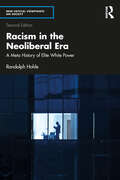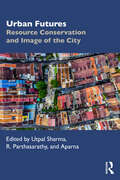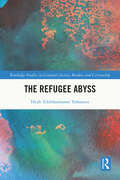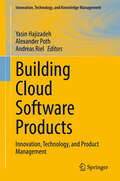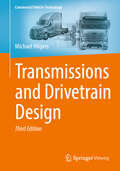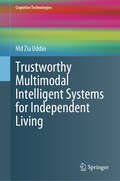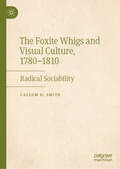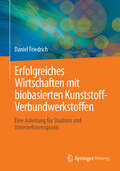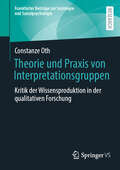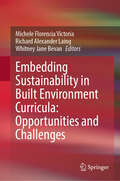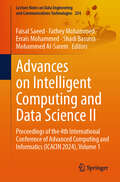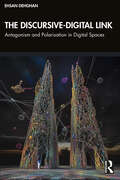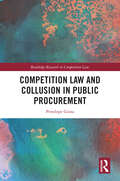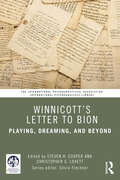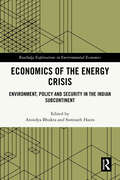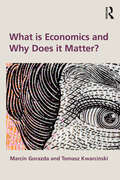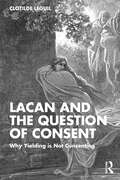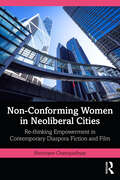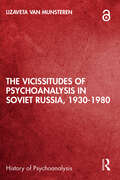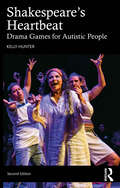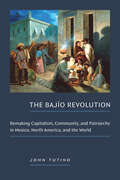- Table View
- List View
Racism in the Neoliberal Era: A Meta History of Elite White Power (New Critical Viewpoints on Society)
by Randolph HohleRacism in the Neoliberal Era explains how simple racial binaries like black/white are no longer sufficient to explain the persistence of racism, capitalism, and elite white power. The neoliberal era features the largest Black middle class in US history and extreme racial marginalization. Racial languages change the meaning of public and private – political economy’s two fundamental terms. Randolph Hohle focuses on how the origins and expansion of neoliberalism depended on a racial language of white-private/black-public. The language of neoliberalism explains how the white racial frame operates like a web of racial meanings that connect social groups with economic policy, geography, and police brutality. When America was racially segregated, elites consented to political pressure to develop and fund white-public institutions. The Black civil rights movement eliminated legal barriers that prevented racial integration. The elite white response to Black civic inclusion was to deregulate the Voting Rights Act and banking policy. Elites gave themselves tax cuts and implemented austerity measures on government programs to aid the poor. They privatized neighborhoods, schools, and social welfare, creating markets around poverty. They oversaw the mass incarceration and systemic police brutality against people of color. Citizenship was recast as a privilege instead of a right. Neoliberalism is the result of an elite white meta-strategy to maintain political and economic power.This new edition is thoroughly revised and updated to take account of the further history and debates over neoliberalism in the Trump and Biden eras and the significant social and political discussions around race and racism, policing, housing, health care, and citizenship as they interconnect with the American neoliberal economic and political system. The new edition will be a vital textbook for students, instructors, and researchers in sociology, politics, race, and economics.
Urban Futures: Resource Conservation and Image of the City
by R. Parthasarathy Utpal SharmaThis book explores the built environment through aspects of spatial planning, ecology, infrastructure, and urban identity. By presenting case studies from both developed and developing nations, the chapters reveal the interconnectedness of urban spaces with socio-economic and cultural dynamics, in addition to ecology and the environment.Urban areas and cities are key players in boosting economic development and enhancing social welfare. Nonetheless, the swift pace of urbanisation presents intricate challenges and obstacles in creating inclusive, sustainable, and resilient living spaces that are modern and capable of accommodating the growing needs of urban populations. This book probes various issues, interventions, and designs from diverse cities, diving into the specifics of sector-related concerns and new insights pertaining to land use planning and its implications, urban design frameworks, green and blue infrastructure, informal settlements, sustainability through resource conservation, transportation modelling, waste management, and ultimately, the image of the city.This book will be advantageous and appealing to students and researchers involved in the built environment, urban planning and design, heritage and vernacular identity, infrastructure, nature-based solutions, and urban studies. It will also attract the attention of professionals and policymakers associated with these fields who are engaged in shaping urban futures.
The Refugee Abyss (Routledge Studies in Criminal Justice, Borders and Citizenship)
by Hyab Teklehaimanot YohannesIn defiance of the refugee abyss, this book presents the flesh of pained bodies and the breath of displaced voices, contributing to the thread of traces yet to be forged and the politics yet to emerge, in a world where Relation takes precedence. The book unfolds in several traces. First, open wounds and scars represent the refugee abyss, revealing the onto-epistemic chains that silence displaced voices. These voices, through embodied subjects, recount their struggles in a world marked by violence. Second, the book questions the rights-based order, revealing how the human rights project is a new incarnation of the colonial civilising mission. It claims to elevate humanity, starting with those deemed uncivilised. Yet, its mask of benevolence, once upheld in the metropoles of empire, now appears hollow. Third, the book theorises the nationstate as a womb-abyss, a matrix that both births and consumes life. Fourth, it explores the refugee abyss as a realm of confinement and destitution, where lives are commodified, exploited, and destroyed. Fifth, it shifts from open wounds to the poetics of refuge, illustrating how life persists in the shadows of rights and laws, while death is inflicted through them. Finally, it reflects on untamed life, emerging from wounds and scars as a proclamation of the unfamiliar and enduring.This book will be of interest to students and scholars of criminology, criminal justice, and refugee studies. It will also appeal to political scientists and policymakers interested in issues of citizenship, human rights, and decoloniality.
Classical Mechanics: A Computational Approach with Examples Using Mathematica and Python
by Vasilis Pagonis Christopher W. KulpClassical Mechanics: A Computational Approach with Examples using Python and Mathematica provides a unique, contemporary introduction to classical mechanics, with a focus on computational methods. In addition to providing clear and thorough coverage of key topics, this textbook includes integrated instructions and treatments of computation.This newly updated and revised second edition includes two new appendices instructing the reader in both the Python and Mathematica languages. All worked example problems in the second edition contain both Python and Mathematica code. New end-of-chapter problems explore the application of computational methods to classical mechanics problems.Full of pedagogy, it contains both analytical and computational example problems within the body of each chapter. The example problems teach readers both analytical methods and how to use computer algebra systems and computer programming to solve problems in classical mechanics. End-of-chapter problems allow students to hone their skills in problem solving with and without the use of a computer. The methods presented in this book can then be used by students when solving problems in other fields both within and outside of physics.It is an ideal textbook for undergraduate students in physics, mathematics, and engineering studying classical mechanics.Key Features: Gives readers the "big picture" of classical mechanics and the importance of computation in the solution of problems in physics Numerous example problems using both analytical and computational methods, as well as explanations as to how and why specific techniques were used Online resources containing specific example codes to help students learn computational methods and write their own algorithms A solutions manual is available via the Routledge Instructor Hub and all example codes in the book are available via the Support Material tab, and at the book’s GitHub page: https://github.com/vpagonis/Classical_Mechanics_2nd_Edition
Computational Intelligence in Engineering Science: First International Conference, ICCIES 2025, Ho Chi Minh City, Vietnam, July 23–25, 2025, Proceedings, Part I (Communications in Computer and Information Science #2584)
by Tzung-Pei Hong Ngoc Thanh Nguyen Yannis Manolopoulos Van Huy Pham Trong Dao Tran Nhien An Le Khac Phu Tran TinThis four-volume set constitutes the refereed proceedings of the First International Conference on on Computational Intelligence in Engineering Science, ICCIES 2025, in Ho Chi Minh City, Vietnam, during July 23–25, 2025. The 115 full papers presented in these proceedings were carefully reviewed and selected from 210 submissions. The papers are organized in the following topical sections: Part I: Machine Learning; Wireless Networks (6G)Part II: Computer Vision; Natural Language ProcessingPart III: Intelligent Systems; Internet of ThingsPart IV: Machine Learning; Control Systems
Building Cloud Software Products: Innovation, Technology, and Product Management (Innovation, Technology, and Knowledge Management)
by Alexander Poth Andreas Riel Yasin HajizadehCloud-native approaches have become essential in IT and OT product development. Cloud-native is more than using the newest cutting-edge services from hyperscalers. Building cloud products benefits from a holistic approach beyond focusing on an isolated cloud paradigm. This book addresses the different aspects of designing, building, and running cloud software products and services from a holistic perspective. It investigates how to empower cloud product and service teams to consider the relevant aspects for long-term success. It provides an overview of selected technologies and practical adoptions and explores various requirements to maintain economic and environmental sustainability. It examines the challenges faced by product management teams of cloud providers, independent software vendors (ISVs), and system integrators (SIs) and offers potential solutions. The chapters also showcase internal success stories and case studies of various companies during the lifecycle of a cloud product. Offering a combination of advanced research from academia and practical industry lessons learned, this book empowers cloud product and service teams to consider and adopt various ideas, concepts, and methods to provide successful, high-quality cloud products and services.
Structural Safety Early Warning and Treatment Technology of Metro Tunnel in Soft Soils (Key Technologies for Tunnel Construction under Complex Geological and Environmental Conditions)
by Dongmei Zhang Rulu Wang Chunsheng Guo Jingya YanThis book mainly focuses on two topics: • The early warning system of the metro structural safety, which includes the monitoring system and inspection system; • The treatment technology for the tunnel disease. In the discussion of the early warning system, several advanced sensing technologies were introduced, which could easily and rapidly detect the potential diseases of the tunnel lining structure. Meanwhile, in the discussion of the treatment technology for the structural problems, several reinforcement measures were introduced in details and corresponding application cases in East China were put out to verify the effects of the measures. From this book, practitioners in the maintenance and repair of metro structures could learn the deformation mechanisms and help address the practical issues they encounter.
Transmissions and Drivetrain Design (Commercial Vehicle Technology)
by Michael HilgersThe aim of this work, consisting of 9 individual, self-contained booklets, is to describe commercial vehicle technology in a concise and illustrative way. Compact and easy to understand, it provides an overview of the technology that goes into modern commercial vehicles. Content of this volume This volume, Transmissions and Drivetrain Design, begins with an explanation of how driving resistance and the engine characteristics factor into the configuration of the transmission and transmission ratios. The transmission and its associated assemblies are presented in detail, providing a clear understanding for training and practical applications. Other components of the drivetrain such as the propeller shaft, the clutch and the retarder are also discussed.
Trustworthy Multimodal Intelligent Systems for Independent Living (Cognitive Technologies)
by Md Zia UddinThis book is an essential guide for anyone interested in how artificial intelligence can enhance the quality of life for individuals who wish to maintain autonomy in their own homes. The author begins by introducing the reader to AI applications in independent living environments, such as smart assisted homes and AI-driven personalization, and thoughtfully explores the ethical challenges involved. With a strong focus on the intersection of technology and human needs, the book provides a detailed roadmap for building intelligent systems that promote safety, independence, and dignity, especially for elderly or vulnerable populations. The author offers both foundational knowledge and critical discussions around the opportunities and limitations of AI when applied to daily life scenarios. A major strength of the book lies in its thorough examination of multimodal systems. Readers are introduced to a rich array of sensor technologies including wearable devices, environmental sensors, vision-based systems, and sound-based inputs. These components are described not only in terms of their individual functionalities but also in how they interact and fuse data to support complex inference tasks. The text walks the reader through system architectures—centralized and distributed—while emphasizing data fusion, synchronization, and real-time versus batch processing. Through practical examples such as fall detection alerts and activity recognition, the book highlights the engineering challenges and solutions involved in building robust, responsive, and user-accepted assistive systems. Ethical deployment, user engagement, long-term maintenance, and family involvement are all addressed in ways that reflect real-world concerns and user diversity. The book also tackles some of the most pressing topics in AI today: data privacy, explainability, and trust. With an entire section dedicated to synthetic data, it explains how artificial data can be used to train effective models while safeguarding user privacy.
The Foxite Whigs and Visual Culture, 1780-1810: Radical Sociability
by Callum D. SmithThis book offers a comprehensive exploration of the intricate relationship between radicalism and sociability in late Georgian parliamentary and extra-parliamentary politics, focusing on the Foxite-Whig faction. Re-evaluating the significance and tactical use of sociability and radicalism in late eighteenth and early nineteenth-century British politics, the book charts not only the rise and fall of a leading and neglected British political faction, but through its interdisciplinary and thematic focus, it seeks to intervene in the field and situate sociability as a key driver and facilitator of late Georgian politics. By utilising original research into contemporary newspapers, letters, diaries, legal records, parliamentary accounts, and especially political caricature, the author offers a new methodological approach in the study of sociability and radicalism and presents original categorisations of contemporary sociability. The book examines how sociability was strategically employed by the Foxite-Whigs and argues for the existence of two primary forms of sociability: insular and porous. Insular sociability manifested itself through dining, drinking to excess, or gambling in a private setting with members of the same aristocratic or political order. Porous sociability however was the extra-parliamentary mechanism by which Fox and his faction tactically opened their insular Whig World to forge connections with the lower orders, French revolutionary leaders, popular radicals, and Irish rebels. The author provides a detailed analysis of Foxite sociability within the context of distinct radical themes, including plebeian radicalism, French Revolutionary radicalism, and Irish radicalism. Beyond its innovative methodological approach to sociability studies, the book foregrounds visual culture as a lens through which to study and enter the &‘wordless experience&’ of the eighteenth century and to view the themes of sociability and radicalism from &‘within.&’ In doing so, the it reveals the inconsequential or informal dynamics of the Foxites&’ political and extra-parliamentary career from their origin in c.1780, to their decline in the early nineteenth century.
Erfolgreiches Wirtschaften mit biobasierten Kunststoff-Verbundwerkstoffen: Eine Anleitung für Studium und Unternehmenspraxis
by Daniel FriedrichDieses Lehrbuch ist eine kompakte Einführung in das Wirtschaften mittels neuartiger, biobasierter Kunststoff-Verbundwerkstoffe als Plastik-Substitutionstechnologie. Es schlägt eine Brücke zwischen der Forschung und der betrieblichen Anwendungspraxis und bietet zahlreiche klausurähnliche Übungen und Musterlösungen zur Vertiefung der Inhalte. Gleichzeitig bietet es neue Einblicke in die betriebliche Nachhaltigkeitstransformation mittels Kunststoffen mit hohem regenerativem Anteil. Der Betriebspraxis bietet sich, neben einer Auffrischung von BWL-Wissen, neue Aspekte der Wertschöpfung aus ökologischeren Kunststoff-Anwendungen.
Theorie und Praxis von Interpretationsgruppen: Kritik der Wissensproduktion in der qualitativen Forschung (Frankfurter Beiträge zur Soziologie und Sozialpsychologie)
by Constanze OthDie Auswertung qualitativen Datenmaterials in Interpretationsgruppen und Forschungswerkstätten ist mittlerweile zu einem methodenübergreifenden Qualitätsstandard avanciert. Es besteht jedoch ein eklatantes und irritierendes Forschungsdesiderat. Um mehr darüber zu erfahren, was in solchen Gruppen geschieht und woher das große Qualitätsversprechen rührt, hat die Autorin Theorie und Praxis von Interpretationsgruppen beforscht. In dieser Arbeit setzt sie sich kritisch mit dem Forschungsstand und den Selbstverständnissen der Gruppeninterpretationspraxis auseinander. Dabei identifiziert sie eine Verschiebung vom Anspruch einer Demokratisierung des Wissens hin zu einem Qualitätsversprechen des besseren Wissens durch Intersubjektivität. Weiter hat sie unterschiedliche Gruppen mit einem (auto-)ethnographischen Forschungsansatz empirisch beforscht und das erhobene Material tiefenhermeneutisch ausgewertet. Ihr Forschungsinteresse galt dabei stets den Bedingungen kritischer Wissensproduktion. Vor diesem Hintergrund stellen sich Fragen an die Gruppeninterpretationspraxis: Wie wollen wir Wissen produzieren? Wie wollen wir (miteinander) arbeiten? Und wie können Räume, wie sie etwa von Interpretationsgruppen und Forschungswerkstätten geschaffen werden, besser und solidarischer genutzt werden?
Embedding Sustainability in Built Environment Curricula: Opportunities and Challenges
by Michele Florencia Victoria Richard Alexander Laing Whitney Jane BevanThis book offers a comprehensive collection of best practices, gathered from classrooms across the globe, aimed at actively engaging students in sustainability. These tried and tested methods, presented within its pages, provide educators with valuable tools that can be easily adopted or tailored to their own academic environments. Moreover, this book serves as resource for policymakers, shedding light on the fundamental drivers and formidable challenges associated with integrating sustainability principles within higher education institutions. As an added bonus, researchers will find an overview of the cutting-edge literature currently available, as well as valuable suggestions for future research.
Advances on Intelligent Computing and Data Science II: Proceedings of the 4th International Conference of Advanced Computing and Informatics (ICACIN 2024), Volume 1 (Lecture Notes on Data Engineering and Communications Technologies #254)
by Faisal Saeed Fathey Mohammed Errais Mohammed Mohammed Al-Sarem Shadi BasurraThis book presents the proceedings of the 4th International Conference on Advanced Computing and Informatics (ICACIn&’24). The conference, held on December 16–17, 2024, at STEAMhouse, Birmingham City University (UK), with a parallel session at Hassan II University (Morocco), attracted submissions by researchers in 20 countries. Out of 91 submissions, 46 high-quality papers were selected, presenting the latest advancements and cutting-edge developments in computing and informatics. The book covers a wide range of advanced computing topics, including data science, big data analytics, the Internet of Things (IoT), smart computing, artificial intelligence, machine learning, cybersecurity, intelligent communication systems, health informatics, and information systems. Designed for researchers, practitioners, and graduate students, this book serves as a valuable resource for exploring advanced intelligent computing techniques and their real-world applications.
The Discursive-Digital Link: Antagonism and Polarisation in Digital Spaces
by Ehsan DehghanWe are in a state of crisis. Democracy is under threat, authoritarian politics are on the rise, and digital media—once heralded as emancipatory technologies—are increasingly implicated in democratic erosion. The Discursive-Digital Link offers a critical framework for understanding the entangled relationships between discourse, digital media, and the hidden dynamics behind antagonism and polarisation.The Discursive-Digital Link presents a fluid social ontology that theorises how discourses and digital communication technologies are inseparably entangled, and how this entanglement contributes to the formation of complex hierarchical relations. Drawing on discourse theory and new materialist perspectives, Dehghan maps how the various components of the discursive-digital link—users, collectives, identities, the medium’s design, underlying neoliberal capitalist logics, and structural power dynamics—together shape antagonistic frontiers in digital spaces. Through detailed case studies across multiple digital media, Dehghan demonstrates how these entanglements manifest through different articulatory logics that could transform societies towards either agonistic progress or disastrous polarisation.By revealing the logics of discursive-digital alliances and active passivity, Dehghan provides critical insights for academics, activists, and anyone seeking to foster progressive togetherness. The Discursive-Digital Link offers a powerful theoretical framework and methodology for analysing digitally mediated communication. It challenges monolithic understandings of polarisation, technological solutionism, and symptom-focused approaches, instead advocating for radical structural interventions across all entangled components of the discursive-digital link—a necessary shift in both academic research and progressive political strategy to address the democratic crises of our time.
Competition Law and Collusion in Public Procurement (Routledge Research in Competition Law)
by Penelope GiosaThis book examines infringements of competition law in public procurement settings, evaluating the latest European Procurement Directive 2014/24/EU to examine to what extent its provisions facilitate or deter collusion during specific award procedures.Public contracts account for a significant proportion of EU expenditure. In sectors such as energy, transport, social protection and the provision of health or education services, public authorities are the main purchasers. It is important to ensure that public contracts are awarded in an open, fair and transparent manner that enables domestic and non-domestic firms to compete on an equal basis, with the aim of improving the quality and lowering the price of purchases made by public authorities. This book assesses the competition law enforcement mechanisms that competition regulators bring to the area of public procurement in the attempt to deter bid rigging. It analyzes key tools for the public and private enforcement of competition law in the domain of public contracts, such as the leniency programme, damages claims for bid rigging and the whistle blower programme. The book uses auction theory as benchmark to assess the risk of collusion in the context of procurement procedures and techniques. Offering a holistic analysis informed by research, it makes recommendations for better design, set up and management of public tenders without distorting competition. Highlighting the need to make use of competition law enforcement mechanisms in the battle against collusion in public procurement, it identifies ways in which the procurement process can be improved, to reduce and prevent bid rigging.The book will be of interest to researchers in the field of competition law, public procurement and EU law.
Winnicott’s Letter to Bion: Playing, Dreaming, and Beyond (The International Psychoanalytical Association International Psychoanalysis Library)
by Steven H. Cooper Christopher G. LovettWinnicott’s Letter to Bion presents reflections on a fascinating moment in the history of psychoanalytic thinking.Donald Winnicott’s letter, sent on October 5, 1967, and conveying thoughts about two of Wilfred Bion’s papers, never received a response. In this book, international contributors elaborate on the contents of the letter, overlapping and divergent projects of the two psychoanalysts, and the meaning of Bion’s silence. The chapters consider topics including the historical context of their work, their focuses on play and reverie, and the question of the sensuous.Winnicott’s Letter to Bion will be of great interest to psychoanalysts in practice and in training, and to historians of psychoanalysis.
Economics of the Energy Crisis: Environment, Policy and Security in the Indian Subcontinent (Routledge Explorations in Environmental Economics)
by Somnath Hazra Anindya BhuktaThe global energy crisis is a two-dimensional phenomenon: on the one hand, the gap between a continuously depleting supply capacity of fossil fuel and rapidly increasing demand for energy is fast widening, and, on the other, the burning of fossil fuels intensifies the problem of global warming day by day.This book explores this global crisis through a regional focus, exploring the issues as they relate to the Indian subcontinent. The book argues that since no source of energy is entirely pollution-free, it is essential to place greater emphasis on enhancing energy-use efficiency. This requires proper auditing of existing energy use and proper management of future use. Providing the foundation for this argument, the first section of the book examines the root cause of the problem: the supply-demand imbalance of energy. Alongside this, market imperfections in energy pricing are also discussed. The second section of the volume explores the environmental and political dimensions, examining policies in the region designed to provide a sustainable environment. The third and final sections present several plausible policy prescriptions to solve the problem.This book will be of particular interest to researchers of energy economics and policy, sustainability, environmental studies and South Asia more broadly.
What is Economics and Why Does it Matter?
by Marcin Gorazda Tomasz KwarcińskiThrough a series of contemporary cases, issues, and applications, this book provides an engaging initiation to the philosophy of economics.The book explores the morality of economics, the role of the state, policies for well-being, and the methods applied by economists. To encourage the idea of debate, the book explores both the pro and contra arguments of key questions: Why can’t economists predict future crises? Why do we pay taxes, and who should pay more? Should we open borders for economic immigrants? Why do we rely on GDP? Is economics an experimental science? By exploring these questions, and many more, the book provides an accessible and thought-provoking overview of current debates in philosophy of economics.This book is an ideal introduction to contemporary issues and questions in the philosophy of economics for all academic readers.
Lacan and the Question of Consent: Why Yielding is Not Consenting
by Clotilde LeguilClotilde Leguil explores the boundary between “consenting” and “yielding” from a Lacanian standpoint.Starting from the definition Lacan gave to psychical and sexual trauma, this book makes the distinction between the ambiguity of consent and the experience of coercion. Clotilde Leguil refers to the #MeToo movement, campaigns against femicides and Vanessa Springora’s book Le Consentement (Consent), elaborating on the various degrees of coercion to demonstrate that desire is not drive and that forcing leaves an indelible mark on the individual. Beyond the legal and contractual approach of consent, this book elaborates on the crucial stakes, both clinical and ethical, that this distinction entails.Lacan and the Question of Consent will be of interest to psychoanalysts and psychoanalytic theorists. It will be relevant for academics and scholars of Lacanian studies, gender studies, feminism and human rights.
Non-Conforming Women in Neoliberal Cities: Re-thinking Empowerment in Contemporary Diaspora Fiction and Film
by Shrimoyee ChattopadhyayThis book investigates the complex role space and movement play in the representation of South Asian diasporic communities in contemporary diaspora literature and films, the question of female empowerment in neoliberal Western cities, and the impact of trauma on female identities. It highlights the literary and cinematic portrayal of South Asian people’s migration to the UK and the US after the Second World War and discusses how the identities of the female characters are transformed in neoliberal cities. Focusing on South Asian women writers and directors, who are first- and second-generation immigrants in the West, the volume analyses how their works depict female empowerment in both British and American settings.The book will be of great interest to scholars and researchers of literature, film studies, diaspora studies, gender studies, and South Asian studies.
The Vicissitudes of Psychoanalysis in Soviet Russia, 1930-1980 (The History of Psychoanalysis Series)
by Lizaveta van MunsterenThis book considers the changing fortunes of psychoanalysis in Soviet Russia from 1930 to 1980.Approaching social history in a psychoanalytic key, Lizaveta van Munsteren argues that the growing split between official and informal languages of the time produced multiple strategies to keep alive the conversation around prohibited subjects. Through original archival research on figures such as Bluma Zeigarnik, Alexander Luria, Filipp Bassin and Dmitry Uznadze, van Munsteren offers a more nuanced understanding of Soviet studies of the unconscious and the role of language in the formation of the mind and in mental disturbances. This book makes a significant contribution to the historiography of psychoanalysis and to the study of the cultural influence of psychoanalysis and its interdisciplinary engagements.The Vicissitudes of Psychoanalysis in Soviet Russia, 1930-1980 will appeal to historians of psychoanalysis and psychology in Soviet Russia, psychosocial researchers and anyone interested in the critical history of psychoanalysis.
Shakespeare's Heartbeat: Drama Games for Autistic People
by Kelly HunterThis updated and revised edition of Shakespeare’s Heartbeat offers a step-by-step guide detailing how to demonstrate, play and perform sensory games based on two of Shakespeare’s most popular plays designed for autistic people of all ages. The original games of heartbeats, eye contact and spatial awareness were created at the Glebe School, Beckenham, with a group of twelve autistic teenagers who met and played with Kelly Hunter once a week over three years, 2002-2005. This second edition brings the book up to date with the additional knowledge Kelly Hunter has gained since then as the founding artistic director of Flute Theatre, the world’s only Shakespearean troupe to focus on the needs of autistic audiences. The book includes the following: A new chapter dedicated to performing A Midsummer Night’s Dream and The Tempest with autistic audiences, including Hunter’s adapted, interactive performance texts of both plays. A new resource for playing with younger autistic children and their families. A new resource for playing with those who require a lower demand approach. A new chapter with targets and techniques to understand the autism puzzle more clearly. New games based on A Midsummer Night’s Dream and The Tempest which have been created over the last ten years, in addition to the original games detailed in the first edition. This book provides an indispensable learning tool for theatre practitioners, drama students, applied theatre students, teachers, autistic people and their families.
A Global Financial History of Oil Crises (Routledge Explorations in Economic History)
by Carlo Edoardo AltamuraIn this book, Altamura analyses the oil shocks of 1973 and 1979, considering their impact on the world economy and subsequent reactions to the global instability.In terms of actors, the focus is on how international organisations such as the IMF, World Bank and OECD responded to the crisis, as well as the behaviour of commercial banks and central banks and of countries in the Global South. Altamura draws on newly available archival material from private financial institutions to paint a full picture of a rapidly changing world which paved the way for stagflation and interdependency.This monograph will be illuminating reading for economic and financial historians, plus scholars looking at energy history, the Cold War in a global context, the New International Economic Order and the political economy of the 1970s.
The Bajío Revolution: Remaking Capitalism, Community, and Patriarchy in Mexico, North America, and the World
by John TutinoIn The Bajío Revolution, John Tutino examines how popular insurgents reshaped Mexico, the United States, and global capitalism during the nineteenth century. After detailing New Spain’s silver-driven wealth, Tutino shows how the Bajío insurgency of 1810–20 broke silver flows and Asian trades, opening markets to industrial cloth made in England from cotton made by enslaved hands in the US South—while Bajío women claimed pivotal roles making maize to sustain families and guerrilla bands. As Mexico gained independence in 1821, mining remained broken while family growers held strong. Then, in the 1830s, a new silver-industrial capitalism fed by family maize makers rose in the Bajío. Women still led rural families and took on mill labor; one woman became Mexico’s leading silver capitalist. Facing that competition, in the 1840s the United States invaded to claim Texas for cotton and slavery and California for gold. The new Mexican capitalism carried on until the United States mobilized gold taken in war to join a global gold standard in the 1870s—blocking Mexico’s independent route to capitalism.
